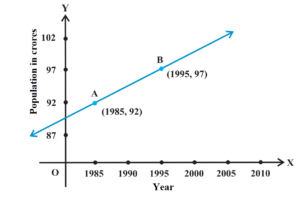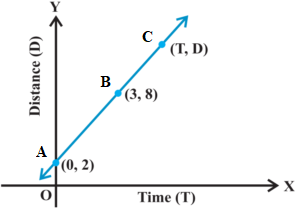Science > Mathematics > Coordinate Geometry > Straight Lines > The slope of Line
In this article, we shall study to find the slope of line AB, when points A(x1, y1) and B(x2, y2) are given.
Type – I: To Find Slopeof a Line When Two Points on the Line are Given:
Example – 01:
Find the slopes of the lines which pass through the points
- (2, 5) and (-4, -4)
Let the points be A(2, 5) ≡ (x1, y1) and (-4, -4) ≡ (x2, y2)
∴ Slope of line AB = (y2 – y1)/ (x2 – x1) = (- 4 – 5)/(- 4 – 2) = (-9)/(-6)
∴ Slope of line AB = 3/2
- (-2, 3) and (4, -6)
Let the points be A(-2, 3) ≡ (x1, y1) and (4, -6) ≡ (x2, y2)
∴ Slope of line AB = (y2 – y1)/ (x2 – x1) = (- 6 – 3)/(4 + 2) = (-9)/(6)
∴ Slope of line AB = – 3/2
- (1, -3) and (-1, -1)
Let the points be A(1, -3) ≡ (x1, y1) and (-1, -1) ≡ (x2, y2)
∴ Slope of line AB = (y2 – y1)/ (x2 – x1) = (- 1 + 3)/(- 1 – 1) = (2)/(-2)
∴ Slope of line AB = – 1
- (2, √3) and (3, 2√3)
Let the points be A(2, √3) ≡ (x1, y1) and (3, 2√3) ≡ (x2, y2)
∴ Slope of line AB = (y2 – y1)/ (x2 – x1) = (2√3 – √3)/(3 – 2) = (√3)/(1)
∴ Slope of line AB = √3
- (3, 4) and (2, 5)
Let the points be A(3, 4) ≡ (x1, y1) and (2, 5) ≡ (x2, y2)
∴ Slope of line AB = (y2 – y1)/ (x2 – x1) = (5 – 4)/(2 – 3) = (1)/(-1)
∴ Slope of line AB = – 1
- (2, 5) and (4, -6)
Let the points be A(2, 5) ≡ (x1, y1) and (4, -6) ≡ (x2, y2)
∴ Slope of line AB = (y2 – y1)/ (x2 – x1) = (- 6 – 5)/(4 – 2) = (- 11)/(2)
∴ Slope of line AB = – 11/2
- (-1, 4) and (2, 2)
Let the points be A(-1, 4) ≡ (x1, y1) and (2, 2) ≡ (x2, y2)
∴ Slope of line AB = (y2 – y1)/ (x2 – x1) = (2 – 4)/(2 + 1) = (-2)/(3)
∴ Slope of line AB = – 2/3
- (a, 0) and (0, b)
Let the points be A(a, 0) ≡ (x1, y1) and (0, b) ≡ (x2, y2)
∴ Slope of line AB = (y2 – y1)/ (x2 – x1) = (b – 0)/(0 – a) = (b)/(-a)
∴ Slope of line AB = – b/a
- (at12, 2at1) and (at22, 2at2)
Let the points be A(at12, 2at1) ≡ (x1, y1) and (at22, 2at2) ≡ (x2, y2)
∴ Slope of line AB = (y2 – y1)/ (x2 – x1) = (2at2 – 2at1)/(at22 – at12)
∴ Slope of line AB = 2a(t2 – t1)/a(t22 – t12)
∴ Slope of line AB = 2(t2 – t1)/(t2 + t1)(t2 – t1)
∴ Slope of line AB = 2)/(t2 + t1)
- The origin, and the mid-point of the line segment joining the points P (0, – 4) and B (8, 0).
Midpoint of segment AB is M( (0 + 8)/2, (-4, 0)/2) = M(8/2, -4/2) = M(4, – 2)
Now slope of OM = (-2 – 0)/ (4 – 0) = -2/4 = – 1/2
Type – II: Find Value of Arbitrary Constant, When Slope is Given:
Example – 02:
Find the value of ‘k’ if the slope of the line passing through the points
- (2, 4), (5, k) is 5/3
Let the points be A(2, 4) and B(5, k)
Slope of AB = (k – 4)/(5 – 2) = 5/3
∴ (k – 4)/3 = 5/3
∴ k – 4 = 5
∴ k = 9
- (2, 5), (k, 3) is 2
Let the points be A(2, 5) and B(k, 3)
Slope of AB = (3 – 5)/(k – 2) = 2
∴ – 2 = 2k – 4
∴ 2k = 2
∴ k = 1
- (k, 2), (-6, 8) is – 5/4
Let the points be A(k, 2) and B(-6, 8)
Slope of AB = (8 – 2)/(-6 – k) = -5/4
∴ 6/(-6 – k) = -5/4
∴ 24 = 30 + 5k
∴ 5k = – 6
∴ k = – 6/5
Type – III: To Show Given Points are Collinear:
Example – 03:
By using slopes show that the following points are collinear.
- A(0,4), B(2,10) and C(3,13)
Given points are A(0,4), B(2,10) and C(3,13)
Slope of line AB = (10 – 4)/(2 – 0) = (6)/(2) = 3 …………. (1)
Slope of line BC = (13 – 10)/(3 – 2) = (3)/(1) = 3 …………. (2)
From equations (1) and (2)
Slope of line AB = Slope of line BC
B is common point
Hence points A, B and C are collinear
- P(5, 0), Q(10, -3) and R(-5, 6)
Given points are P(5, 0), Q(10, -3) and R(-5, 6)
Slope of line PQ = (-3 – 0)/(10 – 5) = (-3)/(5) = – 3/5 …………. (1)
Slope of line QR = (6 + 3)/(-5 – 10) = (9)/(- 15) = – 3/5 …………. (2)
From equations (1) and (2)
Slope of line PQ = Slope of line QR
Q is common point
Hence points P, Q and R are collinear
- L(2, 5), M(5, 7) and N(8, 9)
Given points are L(2, 5), M(5, 7) and N(8, 9)
Slope of line LM = (7 – 5)/(5 – 2) = (2)/(3) = 2/3 …………. (1)
Slope of line MN = (9 – 7)/(8 – 5) = (2)/(3) = 2/3 …………. (2)
From equations (1) and (2)
Slope of line LM = Slope of line MN
M is common point
Hence points L, M, and N are collinear
- D(5, 1), E(1, -1) and F(11, 4)
Given points are D(5, 1), E(1, -1) and F(11, 4)
Slope of line DE = (-1 – 1)/(1 – 5) = (-2)/(-4) = 1/2 …………. (1)
Slope of line EF = (4 + 1)/(11 – 1) = (5)/(10) = 1/2 …………. (2)
From equations (1) and (2)
Slope of line DE = Slope of line EF
E is common point
Hence points D, E, and F are collinear
Type IV: To Find Value of K if Given Points are Collinear:
Example – 04:
If the following points are collinear find value of k using slopes.
- (-2, -3), (k, 4) and (5, 5)
Let given points be A(-2, -3), B(k, 4) and C(5, 5)
Points A, B, and C are collinear
∴ Slope of line AB = Slope of line BC
∴ (4 + 3)/(k + 2) = (5 – 4)/(5 – k)
∴ 7/(k + 2) = 1/(5 – k)
∴ 7(5 – k) = 1(k + 2)
∴ 35 – 7k = k + 2
∴ 33 = 8k
∴ k = 33/8
- (5, k), (-3, 1) and (-7, -2)
Let given points be A(5, k), B(-3, 1) and C(-7, -2)
Points A, B, and C are collinear
∴ Slope of line AB = Slope of line BC
∴ (1 – k)/(-3 – 5) = (-2 – 1)/(-7 + 3)
∴ (1 – k)/(-8) = (-3)/(-4)
∴ (1 – k)/(-8) = (3/4) x (-8)
∴ 1 – k = – 6
∴ k = 7
- (2, 1), (4, 3) and (0, k)
Let given points be A(2, 1), B(4, 3) and C(0, k)
Points A, B, and C are collinear
∴ Slope of line AB = Slope of line BC
∴ (3 – 1)/(4 – 2) = (k – 3)/(0 – 4)
∴ 2/2 = (k – 3)/(- 4)
∴ 1 (-4) = (k – 3)
∴ k – 3 = – 4
∴ k = – 1
- (-4, 5), (-3, 5) and (-1, k)
Let given points be A(-4, 5), B(-3, 5) and C(-1, k)
Points A, B, and C are collinear
∴ Slope of line AB = Slope of line BC
∴ (5 – 5)/(-3 + 4) = (k – 5)/(-1 + 3)∴ 0/1 = (k – 5)/2
∴ 0 = (k – 5)/2
∴ k – 5 = 0
∴ k = 5
- (k, 1), (2, -3) and (3, 4)
Let given points be A(k, 1), B(2, -3) and C(3, 4)
Points A, B, and C are collinear
∴ Slope of line AB = Slope of line BC
∴ (-3 – 1)/(2 – k) = (4 + 3)/(3 – 2)
∴ (-4)/(2 – k) = 7/1
∴ -4 = 14 – 7k
∴ 7k = 18
∴ k = 18/7
Type V: To Prove Given Condition When Collinearity of Points is Given:
Example – 05:
If three points (h, 0), (a, b) and (0, k) lie on a line, show that a/h + b/k = 1
Solution:
Let A(h, 0), B(a, b) and C(0, k) be the points lying on the line.
∴ Slope of AB = Slope of BC
∴ (b – 0)/(a – h) = (k – b)/(0 – a)
∴ b/(a – h) = (k – b)/(-a)
∴ – ab = (a – h)(k – b)
∴ ak – kh + hb = 0
∴ ak + hb = kh
Dividing both sides of equation by kh
∴ ak/kh + hb/kh = kh/kh
∴ a/h + b/k = 1 (proved as required)
Example – 08:
A line passes through (x1, y1) and (h, k). If the slope of the line is m, show that k – y1 = m (h – x1).
Line passes through (x1, y1) and (h, k)
Slope of line = (k – y1)/(h – x1) = m
∴ k – y1 = m (h – x1) (Proved as required)
Example – 09:
Three points P (h, k), Q (x1, y1) and R (x2, y2) lie on a line. Show that (h – x1) (y2 – y1) = (k – y1) (x2 – x1).
As the points lie on a line
Slope of line PQ = Slope of line QR
(k – y1)/(h – x1) = (y2– y1)/(x2 – x1)
∴ (k – y1) (x2 – x1)= (h – x1) (y2 – y1)
∴ (h – x1) (y2 – y1) = (k – y1) (x2 – x1) (Proved)
Type – VI: Interpretation of Graph:
Example – 10:
Consider the following population and year graph, find the slope of the line AB, and using it, find what will be the population in the year 2010?

Solution:
Slope of line AB = (97 – 92)/(1995 -1985) = 5/10 = 1/2
Let the populatiomn in year 2010 be k
Thus point P(2010, k) lies on the line
Slope of AP = Slope of AB
Slope of AP = (k – 92)/(2010 – 1985) = 1/2
∴ (k – 92)/25 = 1/2
∴ 2k – 184 = 25
∴ 2k = 209
∴ k = 104.5
Hence population in 2010 will be 104.5 crore
Example – 11:
In the figure, the time and distance graph of linear motion is given. Two positions of time and distance are recorded as when T = 0, D = 2 and when T = 3, D = 8. Using the concept of slope, find the law of motion, i.e., how distance depends upon time.

Slope of AB = Slope of BC
∴ (8 – 2)/(3 – 0) = (D – 8)(T – 3)
∴ 6/3 = (D – 8)(T – 3)
∴ 2 = (D – 8)(T – 3)
∴ 2(T – 3) = D – 8
∴ 2T – 6 = D – 8
∴ D = 2T – 6 + 8
∴ D = 2T + 2
This relation is known as the law of motion.